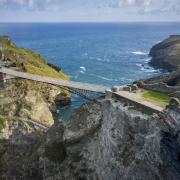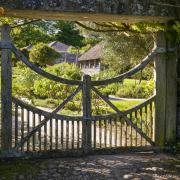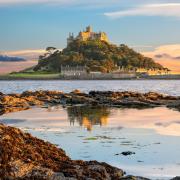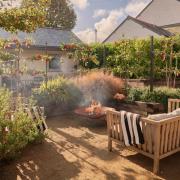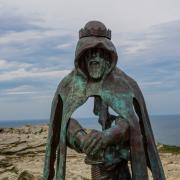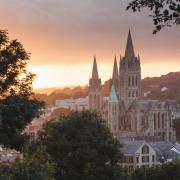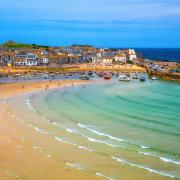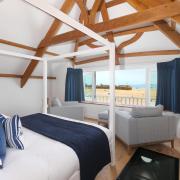From remains buried beneath the sand on a beach, to the city's majestic cathedral, Cornwall's churches each have a story to tell, as David Chapman discovers.
Every community across Cornwall has at least one building that serves as a portal to the past and that is the parish church. In the county we have more than 220 parishes, each with its designated church, and there are a further 400 or more churches, each offering something for us to reflect upon, be that culturally or spiritually.
Way, Way Back
If we want to trace our current churches back to their roots I suppose the best place to look would be beneath the sands of Gwithian where we have the remains of St Govian’s Chapel dating back to the 5th or 6th centuries or Penhale where St Piran’s Oratory, was first constructed probably in the 7th century. St Piran’s Oratory was in use until the 11th or 12th centuries but was subsequently covered by drifting sand and abandoned in favour of a new church nearby on the dunes which itself now lies in ruins.
This is the story for most early Cornish churches. They were founded by the Cornish Saints arriving in the 5th to 7th centuries and then either fell into disrepair or were rebuilt into a more modern generation of churches. Significant periods of rebuilding have taken place in the Norman, Medieval and Victorian eras; with each rebuild a number of features were lost and a variety of tantalising clues left in place.
What Remains
Most of the churches that we see in Cornwall today were largely constructed in the medieval period and many have remnants from the Norman period, examples include St Petroc’s and St Enodoc with Norman fonts; St Clether with Norman masonry and font; Landewednack Church (Lizard), Kilkhampton, Morwenstow and St Germans (which was once the home of the Bishops of Cornwall and was regarded as Cornwall’s cathedral) with Norman doorways.

Compared to medieval/Norman combinations the mighty Truro Cathedral, built from 1880 to 1910, is a baby reflecting a major period of church refurbishment and building by the Victorians. The cathedral is impressive in many ways, not least because it was the first cathedral to be built for many centuries, the previous one, at Salisbury was built from 1220 to 1258. Clearly the cathedral is the biggest church in Cornwall with its incredibly impressive Gothic Revival style towers and spires, the tallest standing 76 metres tall. Our next tallest church at Probus has a tower some 38 metres tall and our largest parish church is St Petroc’s in Bodmin.

Shorter Than Expected
Many of the very earliest churches were more vertically-challenged, in fact a significant number had detached bell towers. It is thought that the towers were built away from the main church building so they could make use of slightly higher ground nearby, however the full story is likely to be more complex than that. We have many detached bell towers including St Feock and St Mylor, both situated in villages of the same name and St Winwaloe (Gunwalloe, Lizard) and St Tallan in Talland, near Looe.

St Winwalloe is a lovely church with plenty of character in a fantastic location. Its bell tower is thought to be 13th century, though it has been repaired. The main church is 15th or 16th century built on the site of a much older church. It has two fonts one Norman the other probably 15th century, a waggon roof to the south aisle and a wonderful rood screen which is said to have been made from the wreck of the St Anthony of Lisbon, which sank in 1527.
Priceless Artefacts
There are many ways in which churches reflect our history and it isn’t always the architecture, many valuable objects are housed in churches. For example the church at St Hilary, which dates back to the 13th century, has a much more recent influence housing some significant works of art created by the Newlyn School of artists in the early 20th century which are partly responsible for the listing of the building.
Artistry is depicted in many ways, one significant method in churches is through the creation of stained-glass windows. At St Neots church we have the most complete set of medieval stained-glass windows in the country. Mostly from the 15th century the windows tell stories of the saints, the most recent is from 1530 which tells the life of St Neot, a 9th century monk who was only 4ft tall. Stained glass is still used as an art form in churches and to tell stories, in All Saints Church, Bryher, a recent installation of stained glass in 2007 by islander Oriel Hicks shows the marine life of the Isles of Scilly.

Some of our church artwork dates back many centuries. St Keverne Church has a significant fresco painting of St Christopher and the infant Christ on its wall, thought to have been painted in around 1480. Even more impressive are the frescos at the church of St Breaca, in Breage. Here we have an astonishing series of 11 medieval wall paintings which were re-discovered in 1891, the two most significant show St Christopher carrying the infant Christ and the other is of The Sabbath Christ. Bloodied and scarred, The Sabbath Christ is intended to be a warning to anyone tempted to break the rules of the sabbath, both figures are shown surrounded by symbols of farming and fishing complete with a mermaid.
The most famous ecclesiastical mermaid is found at St Senarus Church in Zennor. It is thought that the current church was built on top of a Celtic one dating to the 6th century. Inside, much of the building and fixtures have been updated but there is one carved oak bench with two medieval ends, one of which depicts the famous Mermaid of Zennor. Legend has it that a mermaid lured the son of a churchwarden, by the name of Matthew Trewhella, into the sea and he was never found again.

More Mermaids
Continuing the mermaid theme, Robert Hawker (1803 to 1875), the eccentric vicar of St Morwenna Church in Morwenstow liked to dress in unusual ways, he was renowned for knitting and generally wore a gansey but did on occasion dress as a mermaid. As well as being an eccentric, he was a compassionate person known for collecting the bodies of seamen washed ashore on the beaches of his parish and giving them a Christian burial. He is credited with holding the first Harvest Festival celebrations, he built a small wooden hut on the cliffs which we can still visit and he modelled the chimneys of his vicarage on the towers of the churches that he had previously known. But perhaps his most famous contribution to our culture was as a poet, he wrote The Song of the Western Man, or Trelawney as many of us know it.
Literary History
Near Boscastle the church of St Juliot’s has a famous association with Thomas Hardy. In his early years he was an architect and in 1870 he was sent to St Juliot’s Church to plan a restoration. He met Emma Gifford, sister-in-law of the rector, and they fell in love. They were married in 1874 but their marriage wasn’t the happiest and when Emma died in 1912 Thomas was deeply affected and remorseful. He went back to St Juliot’s to erect a memorial plaque to his wife and was subsequently inspired to write much of his most-admired poetry. Since then there has been a memorial plaque to Thomas Hardy and, at the Millenium, The Thomas Hardy Society raised money to install a memorial window.
Daphne Du Maurier was married at Lanteglos-by-Fowey church in 1932, this church features heavily in her first novel, The Loving Spirit, though it was called Lanoc Church. She was also inspired by the church of St Nonna at Altarnun which was the home of her fictional character Reverend Francis Davey in her novel Jamaica Inn.
At St Enodoc we have the grave of poet laureate, Sir John Betjeman. He spent many happy childhood holidays at Trebetherick and immortalised the church in one of his famous poems. He died in 1984 and was buried in the churchyard. We have other famous people in our graveyards including Barbara Hepworth at Longstone Cemetery, Carbis Bay, Bernard Leach at Barnoon Cemetery, St Ives and we mustn’t forget a former prime minister.

In St Mary’s Church, at Old Town on the Isles of Scilly, we have the grave of Harold Wilson, twice prime minister from 1964 to 1970 and again from 1974 to 1976. He loved the islands, had a holiday home near Hugh Town and was buried at Old Town in 1995.
Also at Old Town we have the mass grave of passengers drowned in the sinking of the SS Schiller in 1875. This German liner was carrying passengers between Hamburg and New York when she hit the rocks of Retarrier Ledges. The St Agnes gig picked up some survivors and various ferries and steamers came to her assistance but only 37 of the 372 people on board survived. In the churchyard there is a memorial to one of the passengers, Louise Holzmaister, erected by her husband. It is said that owing to the brave assistance given by the people of the islands to the German passengers the islands should be spared attack by the Germans in both World Wars.

Churchyards all around the county contain poignant graves. My mind is taken to what could be the longest grave in Britain, at St Symphorian’s Church in Veryan. The German vessel, Hera, was lost in thick fog and ran aground on rocks in 1914. Falmouth lifeboat braved huge waves to try to rescue the crew but only five survived. The dead sailors were buried in one grave lying head to toe. The gravestone is only slightly wider than normal but the grave is 30m long. Records show that everyone living in the parish attended the funeral.

Churchyards are significant not only for graves and commemorations but also for a number of other historic artefacts including many Celtic Crosses. For example at Sancreed we have two Celtic Crosses, one standing about 2.5m tall with extremely fine carving; at Cardinham and at St Buryan we have four-holed crosses and St Mawgan has an elaborate lantern cross. At St Clement’s churchyard there is a memorial stone, probably dating back to the 6th century inscribed in Latin, known as the ‘Ignioc Stone’ this memorial is 2.77m tall, made of granite and its inscription reads ‘Vitalus son of Torricus’ and also has the name ‘Ignioc’ inscribed higher up.
The churchyard of St Clement is one of many which takes part in the ‘Living Churchyard’ project in conjunction with Cornwall Wildlife Trust. The idea of this scheme is to promote wildlife by allowing grasses and flowers to grow tall, this attracts insects and then birds and mammals. Other such churchyards include Devoran (good for wildflowers), St Uny (Lelant, good for wildflowers with orchids and a rare mining bee), Herodsfoot (wildflowers can attract marbled white butterflies), Minster (very rare greater horseshoe bat colony), Old Kea (snowdrops), Lanteglos-by-Fowey (wild daffodils). One of the most astonishing churchyards, that of St Teath is also a part of this scheme and in spring the crocuses and daffodils carpet the ground creating a spectacle of colour. For me this is the best sort of memorial to the loved ones we have lost.
This seems like a fitting place to end my brief look at Cornish churches. Clearly there is much more to be seen than I have been able to highlight here but let’s remember our churches and churchyards not only as a place of history and commemoration but also as places for the future, for us all to engage with and rejoice in.





